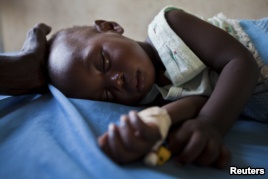VOA常速英语:Killing Mosquitoes Early On
September 02,2013
Targeting mosquitoes in their early stages of life has the potential to greatly boost malaria control efforts and prevent thousands of new infections every year. A new study looks at the effectiveness of – what’s called -- larval source management or LSM. It’s estimated malaria causes 660,000 deaths every year, mostly in sub-Saharan Africa and Asia.
Currently, the main malaria preventive measures are long-lasting insecticide-treated mosquito nets and the indoor spraying of homes. But mosquitoes are building up resistance to the chemicals. That’s one reason why researchers reviewed 13 studies of LSM from Eritrea, Kenya, The Gambia, Mali, Tanzania, the Philippines, Sri Lanka and Greece.
 |
| A young girl with malaria rests in the inpatient ward of the Malualkon Primary Health Care Center in Malualkon, in the South Sudanese state of Northern Bahr el-Ghazal, June 1, 2012. |
Lucy Tusting -- an epidemiologist at the London School of Hygiene and Tropical Medicine -- is the lead author of what’s called The Cochrane review.
“This research was important because a number of malaria endemic countries in sub-Saharan Africa and elsewhere are currently using larval source management. But there’s a real lack of consensus on how effective the method can be and in which settings it’s appropriate. And few studies have so far been conducted to rigorously evaluate the intervention,” she said.
Eliminating mosquitoes before they’re able to transmit the parasite would – on the surface – appear to be a valuable addition to any control program. But Tusting said it’s not a simple decision.
“First of all, we do have very, very effective existing methods of malaria control. Long-lasting insecticide treated nets and indoor residual spraying are both highly effective, rolled out in a vast scale across Africa and elsewhere. And they’ve been undoubtedly a major reason for the successes in malaria control in the last decades. So I think with that in mind there’s been less need to look at other alternative interventions.”
The World Health Organization has issued guidelines on the use of LSM. Currently, the WHO does not recommend using the larvicides in rural sub-Saharan Africa, unless there are particular circumstances that limit the habitats of mosquito larvae. The guidelines say, “Larviciding should be considered for malaria control -- with or without other interventions -- only in areas where the breeding sites are few, fixed and findable.”
The guidelines add, “In most endemic settings, the appropriate way to use larviciding is as a supplement” to nets and spraying. The WHO says, “Larviciding measures may be effective as the leading method of vector control in urban areas.” However, it says “more good quality evidence is needed to support this view.”
Tusting explained how larval source management works.
“Malaria is transmitted by mosquitoes,” she said, “The mosquitoes lay their eggs in standing water and the eggs then hatch and develop into larvae, which then develop into flying adult mosquitoes, which are capable of transmitting malaria. So, larval source management is a method of controlling malaria that works by targeting those immature mosquito stages that are found in standing water.”
Long-lasting insecticide treated nets and residual indoor spraying take aim at adult mosquitoes. Tusting said that LSM would be used in combination with these methods, not in place of them. There are several ways of using larval source management, which could be especially effective in urban areas.
“So, for example, by permanently removing standing water – by draining or filling land – or by making temporary changes to mosquito habitats to disrupt their breeding, for example, by clearing drains to improve water flow. Another common method is larviciding in which chemicals or biological larvicides are added to standing water to kill larvae,” she aid.
Tusting said some research indicates the cost of LSM would be comparable to that of nets and spraying. According to the Roll Back Malaria Campaign, the total cost of the global strategy against the disease is between five and six billion dollars a year.
Her colleague and co-author, Durham University Professor Steve Lindsay, called the review a “landmark publication demonstrating that in many places larval source management should be used as a supplementary weapon against malaria.”
The review says LSM, in appropriate settings, could reduce malaria cases by up to 75 percent and the proportion of people infected with the malaria parasite by 90 percent.
- 频道推荐
- |
- 全站推荐
- 推荐下载
- 网站推荐




















